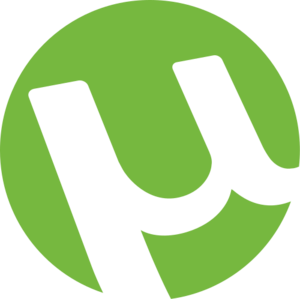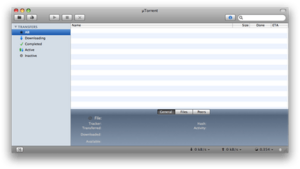- This page was last modified on 17 October 2025, at 10:18. Suggest an edit.
μTorrent facts for kids
 |
|
| Original author(s) | Ludvig Strigeus |
|---|---|
| Developer(s) | Rainberry, Inc. |
| Initial release | September 18, 2005 |
| Stable release(s) | |
| Preview release(s) [±] | |
| 3.6.0 Beta (build 46588) (14 November 2022) | |
| Written in | C++ |
| Operating system | Android, Linux (Server version only), Microsoft Windows, macOS |
| Available in | 60+ languages |
| Type | BitTorrent client |
| License | Adware |
μTorrent, also known as uTorrent, is a popular program used for downloading files with the BitTorrent system. It is owned by a company called Rainberry, Inc.
The "μ" in its name is the Greek letter "mu." It stands for "micro," which is a prefix meaning very small. The program was named this because it was designed to be tiny and use very few of a computer's resources. This meant it could run fast without slowing the computer down.
μTorrent has been around since 2005. In 2015, it faced some criticism. This was because an update included an extra program that used people's computers to mine for cryptocurrency without them knowing.
Contents
History of μTorrent
How It Started
A programmer named Ludvig Strigeus was asked by his friend to create a BitTorrent program that wasn't "bloatware." Bloatware is software that is packed with too many features, making it slow and difficult to use.
Strigeus started working on a small and efficient client in late 2004. He worked on it in his free time for about a month before taking a year-long break. He returned to the project on September 15, 2005. Just three days later, he released the first public version.
New Ownership
On December 7, 2006, the company BitTorrent, Inc. bought μTorrent. They used its code to create version 6.0 and later versions of their own BitTorrent software.
In 2017, it was announced that future versions of μTorrent would work inside a web browser. This allows users to stream files like movies or music directly from their browser, similar to how you watch videos on a streaming website.
What Can μTorrent Do?
μTorrent is small, but it has many useful features.
- Magnet Links: These are special links that let you start a download directly, without needing to download a separate ".torrent" file first.
- Small Size: The program is a single, small file that is easy to run. It doesn't use many computer libraries, which helps keep it tiny.
- DHT Support: This feature, which stands for Distributed Hash Table, helps you find and download files even if the main server (called a tracker) is not working.
- WebUI: This is a tool that lets you control your μTorrent downloads from another computer over the internet using a web browser.
- Bandwidth Scheduler: You can tell μTorrent to use more or less of your internet speed at certain times of the day. This is useful if you don't want downloads to slow down your internet while you're gaming or streaming.
- RSS Downloader: This feature can automatically download new files as soon as they are available from your favorite RSS feeds.
- Easter Eggs: The program has some hidden surprises! If you click the μTorrent logo in the "About" window, it plays a cool sound. If you type the letter "t," a game similar to Tetris called μTris will start.
How μTorrent Makes Money
μTorrent is free to use, but the company makes money in a few ways.
Ads and Toolbars
The free version of μTorrent for Windows shows advertisements inside the program. In the past, the installer also offered to add toolbars to your web browser, like the Ask.com or Bing toolbars. These toolbars would change your browser's homepage and search engine. Users could choose not to install them, but some people installed them by accident.
Paid Version
There is also a paid version called "μTorrent Pro." This version has no ads and includes extra features like a built-in media player and better security tools.
Controversies
In March 2015, μTorrent caused a stir when it began bundling a program called Epic Scale. This software used a person's computer processing power to "mine" for digital money, like Litecoin. This happened in the background, and many users did not realize it was installed.
A developer for μTorrent said that users could decline the installation. However, after many complaints from users, the company removed Epic Scale from the installer. This event serves as a good reminder to always pay attention when installing new software.
What Do You Call It?
How to pronounce "μTorrent" can be confusing. The creator is from Sweden, where the letter μ (mu) is pronounced "my" (like "mee"). So, some people call it "mytorrent."
Others say "microtorrent" because the "μ" symbol means "micro." Many people just say "u-torrent" because the symbol looks like the letter "u." In Greece, where the letter comes from, it's called "me-torrent." There is no single correct way, so you can call it whatever you like!
Which Computers Can Run It?
μTorrent is available for Microsoft Windows, macOS, and Android. There is also a "server" version for Linux that is controlled through a command-line interface.
For newer versions of macOS, which only support 64-bit apps, users are automatically moved to μTorrent Web. This version runs in a web browser instead of as a separate application.
See also
 In Spanish: ΜTorrent para niños
In Spanish: ΜTorrent para niños

